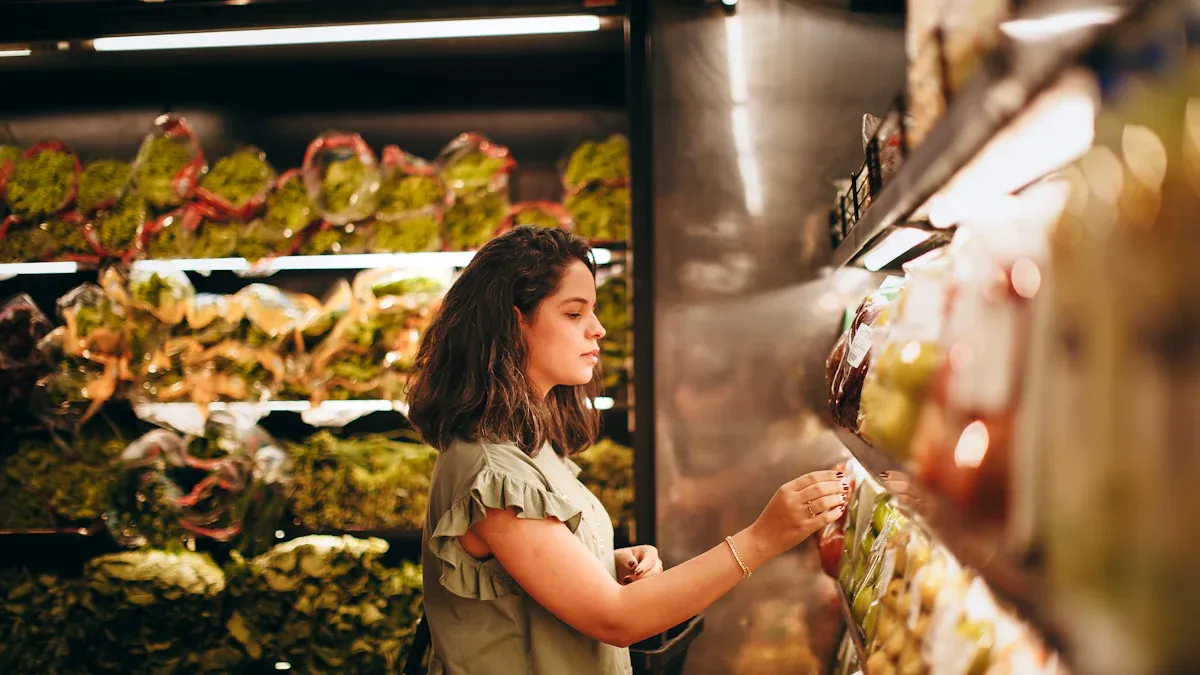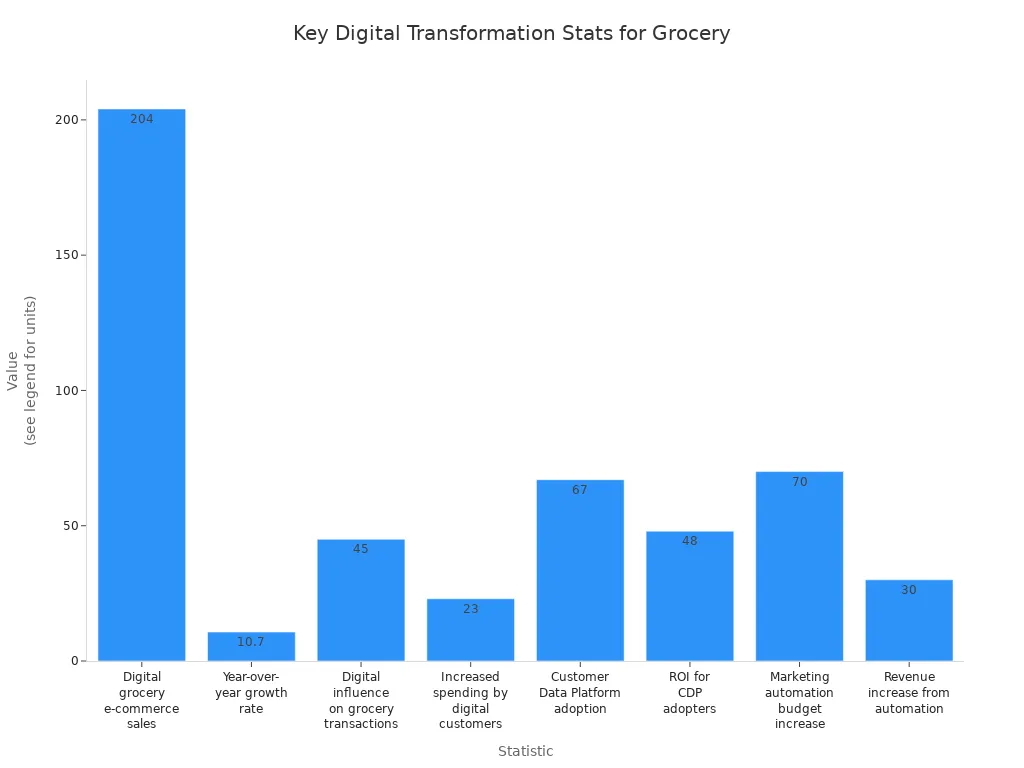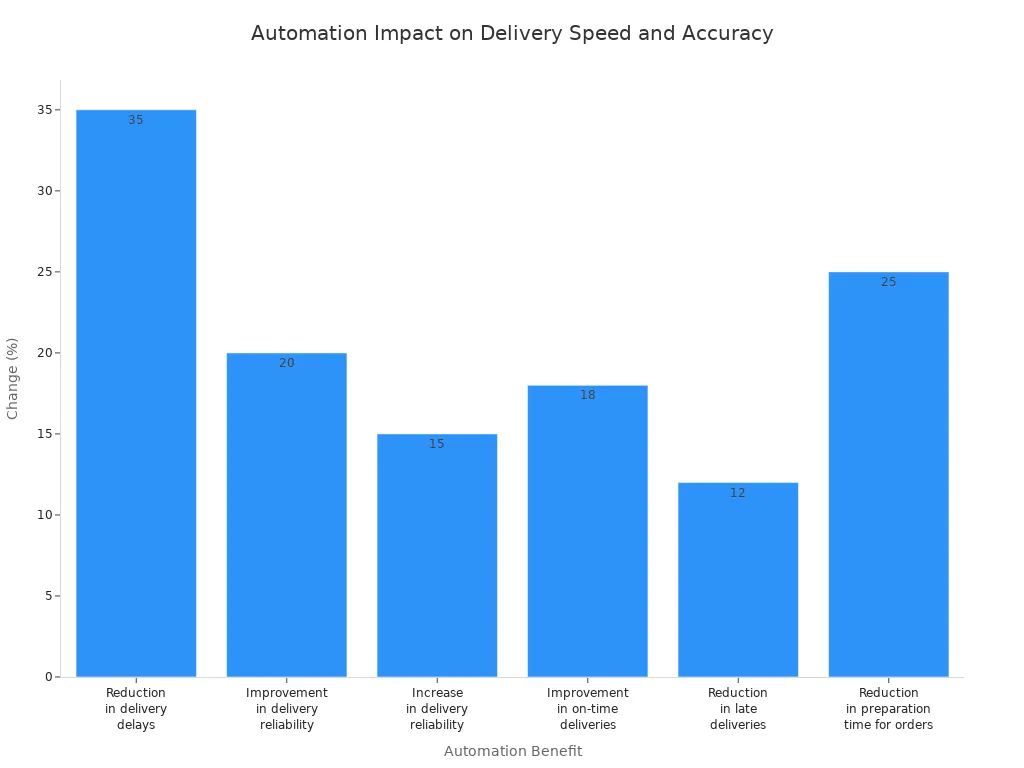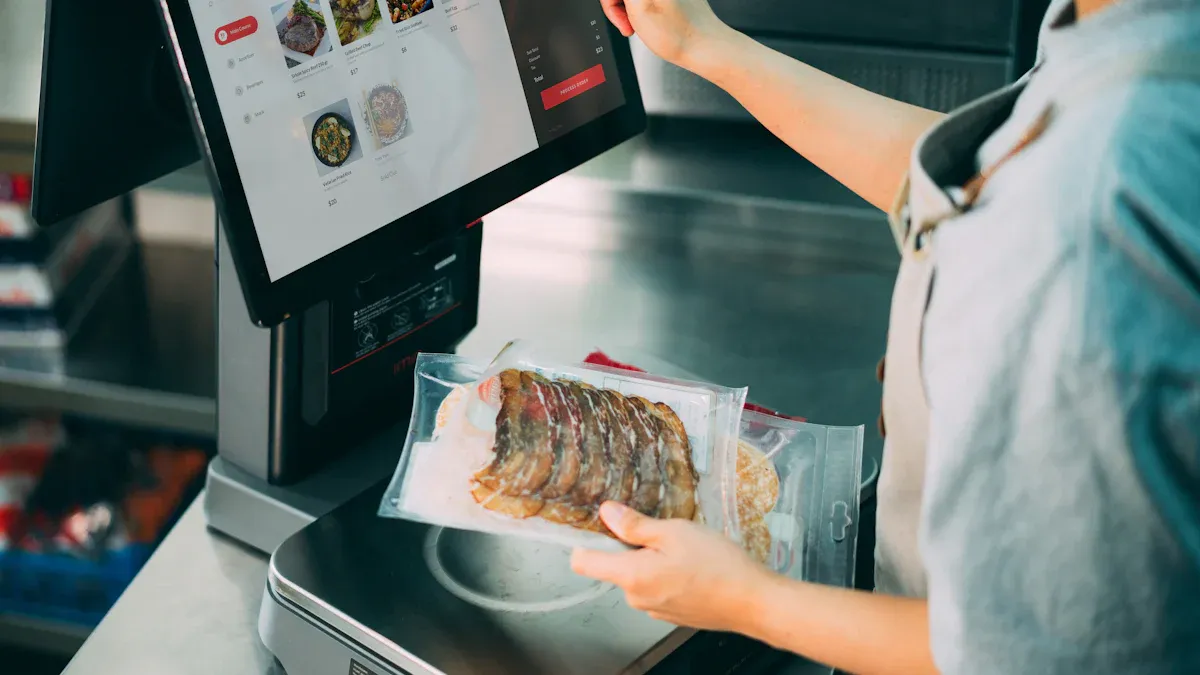Winning Approaches for Digital Transformation in Grocery Chains

Grocery chains are changing fast in today’s market, driven by a robust digital transformation strategy. Digital sales are now $204 billion in 2024, highlighting the impact of this strategy. Almost half of grocery shopping utilizes digital tools, and more than half of US adults—about 148 million people—buy groceries online. Mobile devices account for 60% of online shopping traffic, further emphasizing the need for a strong digital transformation strategy. These facts illustrate why digital transformation is crucial; companies that prioritize customer care and leverage data see results quickly.

Key Takeaways
Digital transformation helps grocery chains keep up with customers and other stores.
Omnichannel integration lets people shop online, in stores, or on apps easily.
Personalized shopping uses customer data to make people want to come back and buy again.
Putting money into e-commerce and automation makes orders faster and keeps track of products better, so customers are happier.
Watching key performance indicators helps grocery stores see how well they are doing and change plans to get better results.
Digital Transformation Strategy for Grocery Chains
A digital transformation strategy helps grocery stores keep up with what customers want. It also helps them follow new trends in the market. Experts say there are a few important steps to do well:
Look at customer data to find patterns and trends.
Make plans that match what customers like and how they shop.
Give special deals and ads to certain shoppers to boost online sales.
Stores change how people buy things by letting them shop online or in person. They spend money to make shopping easy and personal for everyone. Automation helps them work faster when filling online orders. Loyalty programs help stores earn trust and keep customers coming back.
Omnichannel Integration
Omnichannel integration links real stores with online shopping. This makes shopping smooth for everyone. People can look at products online, get them delivered, or pick them up at the store. Data analytics help stores make shopping more personal, which makes customers happier.
Stores face some problems with omnichannel integration:
Technology integration means connecting e-commerce, POS, and CRM systems. Sometimes, data does not match or systems do not work together.
Customer experience should be the same everywhere. But different tech and customer needs make this hard.
Inventory management needs updates all the time to stop running out or having too much.
Data management gets tricky with lots of information from many places.
Supply chain work for shipping, returns, and pickups adds more steps.
Stores also have trouble with slow order fulfillment and meeting fast delivery needs.
Tip: Grocery stores should use good warehouse management systems. This helps them fill orders faster and deliver quickly.
Good omnichannel strategies make customers more loyal and happy. Stores use customer data from many places to make better ads. Omnichannel integration also helps stores run better by improving inventory management.
The table below shows examples of grocery brands that did well with omnichannel integration:
Brand | Strategy Description | Key Outcomes |
|---|---|---|
Tesco | Used website, app, and stores with a loyalty program. | Got more customers and loyalty by making shopping personal. |
Marks & Spencer | Used omnichannel and a loyalty program for special rewards. | Made customers happier and got more repeat shoppers. |
Boots | Started Click & Collect for picking up online orders in-store. | Over 70% of online orders picked up in-store, making shopping better for customers. |
Sainsbury’s | Gave easy shopping on all channels with a loyalty program. | Made operations smoother and increased sales with better customer experience. |
Kroger | Joined stores, digital, and mobile shopping. | 90% of delivery and pickup shoppers also shop in-store, making customers more engaged. |
Kroger is special because it has many delivery options and automated centers. This helps Kroger do better in online shopping and fast delivery.
E-Commerce Capabilities
E-commerce is very important for grocery stores. In 2024, 12.5% of grocery shopping was online. Experts think this will go up to 13.8% in 2025. Grocery stores need to focus on what customers want most.
Feature | Description |
|---|---|
Personalization | Special offers and messages based on customer data to keep shoppers coming back. |
Seamless Online Shopping Experience | Easy to use websites, simple checkout, and many ways to pay help customers enjoy shopping. |
Enhanced Fulfillment Options | Real-time inventory and many delivery or pickup choices meet customer needs. |
Mobile Optimization | Websites that work well on phones make shopping easy for everyone. |
Customers want shopping that fits their needs. They like good service and special offers just for them. Having different ways to pay is also very important.
Stores need a digital transformation strategy to make their online shops better. They should study customer data, give special deals, and offer many ways to get groceries. Mobile optimization matters because most people shop with their phones.
Note: Grocery stores that spend money on e-commerce and omnichannel integration will grow and keep customers for a long time.
Enhancing Customer Experience

Personalized Shopping
Grocery chains use digital transformation to make shopping feel special. They gather data from loyalty programs and online orders. This helps them learn what each shopper likes. Stores then give special offers and suggestions that match people’s habits.
Technology | Description |
|---|---|
AI | Gives shoppers ideas and swaps based on what they buy and like. |
Digital Kiosks | Help people find items and deals fast, making shopping easier. |
Loyalty Programs | Watch shopping habits to give custom discounts and rewards. |
Personalized shopping does more than make people happy. It helps stores be different from others. When shoppers get offers that fit them, they feel important. This makes them want to come back and spend more.
Key Point | Description |
|---|---|
Customer Experience | Custom shopping builds loyalty by matching what shoppers like. |
Incremental Spending | Special deals and tips make customers buy more. |
Competitive Advantage | Personalization helps stores connect with shoppers better than others. |
Digital transformation puts the customer first. It gives smooth, personal experiences for shoppers.
Mobile App Engagement
Mobile apps help make grocery shopping easier and more fun. A good app lets people look at products, check prices, and get deals on their phones. Easy-to-use features and personal tips keep shoppers interested.
Feature | Description |
|---|---|
Seamless App Navigation | Simple layouts help users find things without trouble. |
Personalization | Apps suggest products and deals from past shopping, making it faster and easier. |
End-to-End Ecosystem Integration | Apps work with websites and stores for a smooth experience everywhere. |
Mobile self-checkout saves time and makes shopping quick and easy. This keeps customers coming back.
When an app remembers favorite items and gives discounts, shoppers feel noticed and special.
Self-scanning and price checks build trust. Customers see their spending right away, so there are no surprises.
A strong digital transformation uses mobile apps to connect with shoppers. It helps stores build loyalty and make every visit better.
Digital screens and apps make shopping more fun and personal.
Better supply chains and inventory mean fresher food and fewer empty shelves.
Metric | Description |
|---|---|
Shows how happy customers are with shopping. | |
Net Promoter Score (NPS) | Tells if customers will tell friends about the store. |
Customer Effort Score (CES) | Shows how easy it is for customers to shop or order. |
On-time delivery rate | Checks how often orders arrive when they should, which matters for happiness. |
Order accuracy | Checks if customers get the right things, which builds trust. |
Substitution acceptance rate | Shows how often customers take replacement items, proving if they trust the store’s choices. |
Optimizing Operations
Inventory Management
Grocery chains must manage inventory well to keep shelves full. This helps customers find what they want. Real-time inventory tracking shows stores what is in stock. This stops items from running out. Digital tools help stores see low stock and make orders fast. They also help stores get reports quickly.
Some top inventory management software are:
Software Name | Key Features |
|---|---|
CATAPULT | Scale integration, perpetual inventory tracking, suggested order amounts, custom shelf label printing |
Markt POS | Seamless scale and label printer integration, weight-based tracking, perishable inventory features |
Lightspeed | Multilocation and e-commerce features, suitable for expanding businesses |
IT Retail | Real-time inventory tracking, stock level adjustments, 24/7 support |
Real-time systems link store inventory with online shopping. This lets customers check what is in stock before shopping. Accurate inventory means fewer mistakes and less wasted food. Stores using digital transformation keep products on shelves and avoid losing sales.
Tip: Real-time inventory management helps stores get orders right and makes customers happier.
Automation and Supply Chain
Automation makes grocery supply chains faster and more dependable. Stores use machines and robots to move products. Robotic arms and guided vehicles help move items around. Voice-activated picking systems help workers pick orders with fewer mistakes. Automated packaging systems pack orders quickly.
Northeast Grocery saved $40 million by updating its IT systems. AI tools help stores keep the right amount of stock and waste less food. Generative AI helps with marketing and making decisions.
Aspect | Description |
|---|---|
Improved Pricing Strategies | AI systems provide real-time insights into price elasticity, optimizing regular pricing and markdowns. |
Markdown Optimization | Implementing optimized markdowns can lead to a 15% reduction in markdown costs for retailers. |
Reduced Waste | Dynamic pricing helps sell products before expiration, minimizing food waste. |
Enhanced Operational Efficiency | Aligning supply chain and promotions boosts revenue and profitability while streamlining operations. |
Brightpick’s robots pick and pack orders in warehouse aisles. This makes order fulfillment faster. Automation in the supply chain means fewer late deliveries and more orders on time.

A digital transformation strategy helps grocery chains use these tools. This improves speed, accuracy, and customer service.
In-Store Digital Innovation

Digital Screens
Digital screens help stores talk to shoppers. These screens grab attention and show deals. Stores put screens in busy spots to guide people. Screens show new products and help shoppers find them. Good screens make products easy to see. They can make people buy things they did not plan to buy, especially near checkout. Shoppers remember stores with fun screens. This helps stores keep loyal customers.
Many shoppers want certain things on digital screens:
Shopper Preference | Percentage |
|---|---|
Sales and promotions | 55% |
Price comparison features | 55% |
Product demonstrations and inspiration | 35% |
Real-time inventory information | 37% |
Grocery department engagement | 28% |

Digital shelf screens and audio ads get noticed by shoppers. About 30% of people see digital shelf screens. Around 37% hear audio ads in stores. These tools help stores show new items and special deals. They also help shoppers compare prices and check what is in stock.
Stores use digital screens to:
Get shoppers’ attention and show products.
Make people buy things on impulse.
Help shoppers connect with brands.
Show new products and deals.
Connected Store Technology
Connected store technology uses smart devices in stores. These tools help shoppers and workers. Automated checkout makes shopping faster. In 2023, stores got over 217,000 self-checkout terminals. Smart shelves and digital price tags give updates on stock and prices. This helps stores manage inventory better.
Shoppers want shopping that feels personal. About 71% like stores with custom shopping. Around 76% get upset when stores do not offer this. Connected technology helps stores give shoppers what they want.
Benefits of connected store technology include:
Better shopping with custom features.
Employees work faster with smart tools.
Stores earn more by keeping customers and managing inventory.
Smart shelves, digital price tags, and automated checkout help stores run well. Workers do their jobs faster. Shoppers have a better time in the store. Stores that use smart technology can keep up with what shoppers want and stay ahead.
Rapid E-Commerce Deployment
Grocery chains must open online stores fast. This helps them keep up with what shoppers want. Rapid e-commerce deployment lets stores compete and serve people better. Many stores use smart steps to make this happen quickly.
Quick Start Solutions
Some grocery chains do well by following simple steps:
Integrate Online and Offline Channels: Stores link their websites, apps, and real locations. This gives shoppers a smooth way to buy things.
Build End-to-End Capabilities: Stores handle their brand and customer ties themselves. Loyalty programs and mobile apps help keep shoppers interested.
Collect First-Party Data: Stores get info from their own websites and apps. This helps them learn what shoppers want and make their service better.
Real examples show stores can open online shops fast:
The Save Mart Companies worked with Swiftly to make their app better. This made it easier for shoppers to use loyalty programs.
H-E-B built new centers for online orders. These centers help with curbside and home delivery, so orders get filled faster.
Lakeview Farm Store started selling online with Wave Grocery. This helped them find more shoppers and sell more items.
Leshop became the biggest online supermarket in Switzerland after starting in 1998. The store grew fast and made money in eight years.
Mobile apps are important for quick online store launches. They let shoppers order, get deals, and change how they shop. Earth Fare’s app helped shoppers save money and waste less food.
Fast Commerce Platforms
Fast commerce platforms have tools that help stores open and grow fast. These platforms focus on speed, easy changes, and making shoppers happy.
Feature | Description |
|---|---|
Shoppers get deals based on what they buy. | |
Quick and seamless checkout | Fast checkout means fewer people leave without buying. |
Time-effective curbside pickup program | Shoppers order online and pick up at the store. This saves time and makes shopping easier. |
Flexible products and changing deals help stores keep up with what shoppers want. Fast commerce platforms give grocery chains what they need to do well online.
Data-Driven Growth
Customer Insights
Grocery chains use customer insights to make smart choices. They look at how people shop and what they buy. Many shoppers change how they shop when prices rise. About 83% of people now shop in new ways because of the economy. Almost half of shoppers, 44%, make lists before going to the store. Many people pick private label products and use coupon apps to save money.
Retailers focus on three main things to learn about shoppers:
Product assortment helps stores stock items people want.
Pricing strategy helps stores set prices and deals that attract buyers.
Marketing effectiveness shows which ads work best for each group.
Stores use data-driven strategies to grow their business. They find top-selling products and keep them in stock. They look at order patterns by time and day to work better. Market basket analysis helps stores bundle products that people buy together. These steps help stores sell more and keep shoppers happy.
Tip: Stores that use a digital transformation strategy can learn more about their customers and make better choices.
Measuring Success
Grocery chains measure success by tracking key numbers. These numbers show how well stores use technology and data. The table below lists important performance indicators:
KPI | Description |
|---|---|
Sales Revenue | Total value of transactions over a set time, showing financial health. |
Gross Profit Margin | Percentage of sales kept after paying for goods, showing how much profit stores make. |
Inventory Turnover | Speed at which stores sell products, important for fresh food. |
Average Transaction Value | Average amount spent per visit, showing customer spending habits. |
Customer Retention Rate | Percentage of shoppers who return, showing loyalty. |
Sell-Through Rate | Percentage of inventory sold in a period, showing how well stores manage stock. |
Stores use these numbers to see what works and what needs to change. They can change their digital transformation strategy to get better results. Tracking these numbers helps stores stay ahead and meet customer needs.
Grocery chains do well when they use digital transformation strategies that put customers first and use new technology. They make shopping better with things like omnichannel experiences, mobile apps, and automation.
Spending money on digital innovation helps stores get bigger and beat other stores.
In July 2025, U.S. online grocery sales hit $10 billion, which means more people are shopping online.
Now, more than 60% of families buy groceries on the internet.
Big stores like Walmart and Target use AI to make their service and work better.
Digital tools help stores see what is happening right now, so they can change fast and do well.
FAQ
What is digital transformation in grocery chains?
Digital transformation is when grocery stores use new technology. They add things like online shopping and mobile apps. Smart tools help stores work better and faster. These changes make shopping easier for everyone.
How does omnichannel integration help shoppers?
Omnichannel integration gives shoppers more ways to shop. People can buy online, pick up at the store, or get delivery. They can use websites, apps, or visit in person. This makes shopping simple and flexible.
Why do grocery stores use mobile apps?
Mobile apps help shoppers find what they need fast. People can see deals and check prices on their phones. They can make lists and order groceries easily. Apps make shopping quick and personal.
What are the benefits of automation in grocery stores?
Automation helps stores fill orders fast and keep shelves full. Robots and smart systems make fewer mistakes. Stores save time and money with these tools. Customers get fresher food and better service.
How do stores use customer data?
Stores collect data from loyalty programs and online orders. They look at this data to see what shoppers like. Stores use these insights to give special deals. This helps them make service better for everyone.
See Also
Understanding AI-Driven Corner Stores: Essential Insights for Retailers
Comparing Micromarkets and Smart Stores: Global Retail Automation Insights
The Future of Retail: Embracing AI-Driven Store Innovations
Transforming Online Retail Management with AI-Enhanced E-Commerce Tools
Examining Walgreens Self-Checkout: Benefits and Hurdles in Retail
